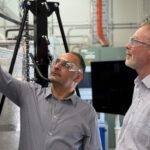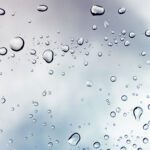Research led by Curtin University geologists has uncovered a wealth of new evidence in the mineral zircon from lunar rock samples recovered during NASA’s Apollo missions, revealing indisputable proof of meteorite collisions on the Moon.
Headed by microstructural geology experts Dr Nick Timms and Professor Steven Reddy of the Western Australian School of Mines (WASM), the study documents the discovery of impact-related shock features in lunar zircon, giving scientists a new conceptual framework to explain the history and timing of meteorite impact events in our solar system.
Dr Timms said the discovery was made while looking more closely at lunar zircon mineral grains, with the use of microscopy facilities at Curtin, and finding the presence of preserved microscopic details, known as planar deformation features (PDFs), as well as micro-twins (impact indicators), which are only ever produced by large-scale meteorite impacts.
“This research is the first to report the presence of PDFs and micro-twins in lunar zircon, which provide unequivocal evidence of the immense pressures that occur during an impact event,” Dr Timms said.
“This research also provides a new explanation of how these features form. As shock waves pass through a rock, fractions of a second after a meteorite impact, these features form like microscopic crumple zones which are caused by directional differences in zircon’s elasticity.”
Dr Timms said the research, which characterises the impact shock features, would provide a new framework for scientists to interpret impact-related data.
“The new conceptual framework allows lunar scientists to recognise whether complex zircon grains can be explained by a single impact event, or require more than one impact event,” he said.
“Furthermore, our new approach allows us to recognise impact-related features in zircon in lunar and terrestrial rocks that would otherwise be overlooked or difficult to find.
“This helps us to overcome one of the major problems with studying the impact history of the Earth, as direct evidence of impacts, such as craters, become eroded and destroyed through processes of plate tectonics, so much so that none are preserved from the earliest periods of the Earth’s history.”
Dr Timms said the research was a step closer to the major scientific goal of establishing the absolute timing of meteorite impact events on the Moon, and consequently, the inner solar system.
“The current paradigm for the early impact history of our solar system stems from studies of lunar rocks and involves a period of intense impact events around 3.9 billion years ago, known as the ‘Late Heavy Bombardment’,” he said.
“Recent dating of grains of the mineral zircon in lunar samples by the research group at Curtin shows a range of ages that challenges this view and we anticipate the new framework will help us to test if this bombardment is recorded in similar age zircon grains on Earth.”
This research was the result of a collaborative effort between the Curtin research group in Applied Geology, Dr Nick Timms, Professor Steven Reddy, Associate Professor Alexander Nemchin, Dr Marion Grange and Professor Bob Pidgeon, as well as Dr Rob Hart from the Materials Characterisation Group in Curtin Applied Physics and Dr Dave Healy at the University of Aberdeen, UK.
The Curtin research group in Applied Geology is a pioneer in its field and is currently leading the world in the application of quantitative microstructural techniques to zircon research. In 2006, they also made the discovery that zircon could deform in the Earth’s crust and that the structures formed in this deformation could help modify the geochemistry of zircon.
The group’s most recent paper, Resolution of impact-related microstructures in lunar zircon: A shock deformation mechanism map, is published in the internationally esteemed journal, Meteoritics and Planetary Science.
Contacts :
Dr Nick Timms, Dept of Applied Geology, WASM, Curtin University
Tel: 08 9266 4372, Email: n.timms@exchange.curtin.edu.au
Professor Steven Reddy, Dept of Applied Geology, WASM, Curtin University
Tel: 08 9266 4371, Email: s.reddy@ curtin.edu.au
Andrea Barnard, Public Relations, Curtin University
Tel: 08 9266 4241, Mob: 0401 103 755, Email: andrea.barnard@curtin.edu.au
Web: www.curtin.edu.au


